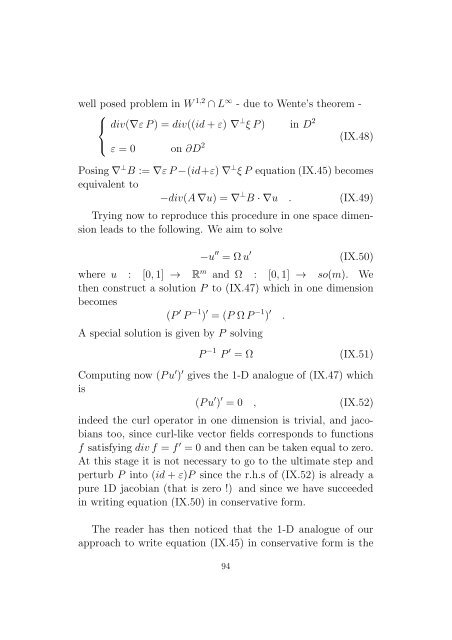Conformally Invariant Variational Problems. - SAM
Conformally Invariant Variational Problems. - SAM
Conformally Invariant Variational Problems. - SAM
You also want an ePaper? Increase the reach of your titles
YUMPU automatically turns print PDFs into web optimized ePapers that Google loves.
well posed problem in W 1,2 ∩L ∞ - due to Wente’s theorem -<br />
⎧<br />
⎨ div(∇εP) = div((id+ε) ∇ ⊥ ξP) in D 2<br />
(IX.48)<br />
⎩<br />
ε = 0 on ∂D 2<br />
Posing∇ ⊥ B := ∇εP−(id+ε)∇ ⊥ ξP equation(IX.45)becomes<br />
equivalent to<br />
−div(A∇u) = ∇ ⊥ B ·∇u . (IX.49)<br />
Trying now to reproduce this procedure in one space dimension<br />
leads to the following. We aim to solve<br />
−u ′′ = Ωu ′<br />
(IX.50)<br />
where u : [0,1] → R m and Ω : [0,1] → so(m). We<br />
then construct a solution P to (IX.47) which in one dimension<br />
becomes<br />
(P ′ P −1 ) ′ = (P ΩP −1 ) ′ .<br />
A special solution is given by P solving<br />
P −1 P ′ = Ω<br />
(IX.51)<br />
Computing now (Pu ′ ) ′ gives the 1-D analogue of (IX.47) which<br />
is<br />
(Pu ′ ) ′ = 0 , (IX.52)<br />
indeed the curl operator in one dimension is trivial, and jacobians<br />
too, since curl-like vector fields corresponds to functions<br />
f satisfying divf = f ′ = 0 and then can be taken equal to zero.<br />
At this stage it is not necessary to go to the ultimate step and<br />
perturb P into (id+ε)P since the r.h.s of (IX.52) is already a<br />
pure 1D jacobian (that is zero !) and since we have succeeded<br />
in writing equation (IX.50) in conservative form.<br />
The reader has then noticed that the 1-D analogue of our<br />
approach to write equation (IX.45) in conservative form is the<br />
94
















